Created by the renowned Sid Sackson and winning the Spiel Des Jahres in 1981, Domination (also known as Focus) was a game that I didn’t really know what to think about it. Sid Sackson is a well known board game designer that has created many memorable board games. Winning the Spiel Des Jahres is also usually a really prestigious award and is usually a good sign that a board game is going to be good. I was still a little skeptical of Domination though. Early winners of the Spiel Des Jahres were different than recent winners of the award as the criteria and games in the running were quite different than they are today. That is noticeable by the fact that the game was made 17 years before it won the award and the previous year it was a runner up. Back in the early days the Spiel Des Jahres was mostly used to give recognition to board games that the judges really liked as there was no requirement that the game was made in the last year. For this reason I didn’t know what to expect out of Domination as board games have developed quite a bit since Domination was created and won the Spiel Des Jahres award. Domination has some interesting and clever ideas that were before their time, but due to some issues the game can become boring after a while.
How to Play Domination
Setup
- Each player chooses which color they are going to play and takes the corresponding number of pieces. The number of pieces and colors that are used depends on the number of players:
- Two Players: Green and Red Playing Pieces – 18 of each color
- Three Players: Green, Red, and Blue Playing Pieces – 13 of each color
- Four Players: Green, Red, Blue and Yellow Playing Pieces – 13 of each color
- Take one playing piece of each color that is in the game. One player randomly selects one of the pieces to determine who will start the game.
- Setup the gameboard as shown below based on the number of players.
- This is the setup for a two player game.
- This is the setup for a three player game.
- This is the setup for the four player game.
Playing the Game
On a player’s turn they will make one move. They can either make a single move, a multiple move, or a reserve move.
In a three player game on each player’s first turn they must play their one piece that was kept off the gameboard to an unoccupied space on the gameboard.
After a player has made their move play will pass to the next player clockwise.
Single Move
In a single move the player moves one of their playing pieces which is on a space by itself. This piece can be moved one space vertically or horizontally. The piece may never be moved diagonally. The piece can either be moved to an empty space, or a space with one or more playing pieces on it. If a piece is moved to a space with a stack of pieces on it, the piece that was just moved is placed on the top of the stack. A player can move their playing piece onto a stack containing their own pieces, pieces of other players, or both.
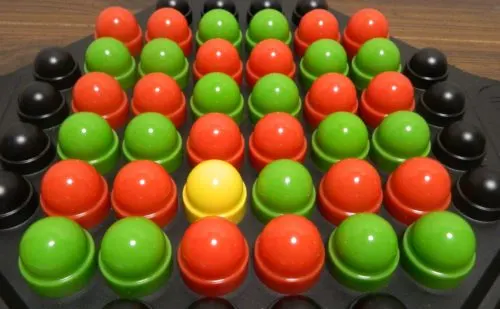
The yellow piece can be moved one space up onto the red piece, one space left onto the red piece, one space down onto the red piece, or one space to the right onto the green piece.
Multiple Move
The other move that a player can make is a multiple move. In a multiple move a player can move a whole stack of pawns. A player may only move a stack if their pawn is on top of the stack. When a player wants to move a stack they choose how much of the stack that they want to move. They can either move the entire stack or take some pieces off the top of the stack and leave some of the playing pieces behind.
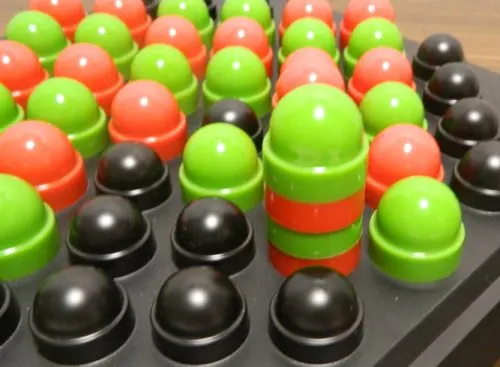
The green player controls this four high stack. They can either move the entire stack up to four spaces or split the stack. They can move the top piece on the stack one space, the top two pieces two spaces, or the top three pieces three spaces.
The player will then be able to move the stack a number of spaces up to the height of the stack they are moving. They can move the stack vertically or horizontally but not diagonally. When moving a stack it will only impact the pieces on the space that that stack lands on and won’t impact the pieces on the spaces that the stack was moved through.
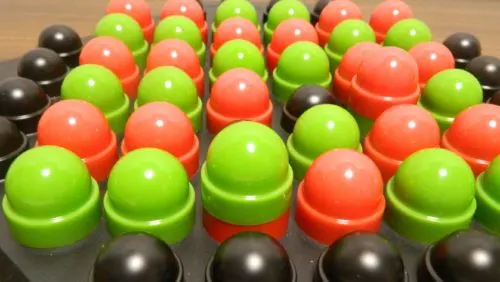
The green player is in control of the two piece stack on the bottom of the picture. They can move this piece one or two spaces left, right, up or down.
Reserving and Capturing Pieces
After moving your playing piece/stack you need to check the height of the stack that you moved the piece(s) to. If the new stack ever contains more than five pieces some of the pieces will be removed from the stack. Starting with the playing piece on the bottom of the stack, you will remove pieces until the stack only has five pieces remaining.
The pieces that were removed from the board will either be captured or put into reserve. All pieces not belonging to the player who made the move are captured. These pieces are removed and won’t be used for the rest of the game. Pieces belonging to the player who made the move will be added to their reserve pile.

This stack has seven pieces in it. Since the stack can only have five pieces in it, the bottom two pieces will be removed. The green player moved this piece as their piece is on top of the stack. The bottom green piece will be added to the green player’s reserve pile. The red piece second from the bottom will be removed from the game.
Reserve Move
If a player has playing pieces in reserve they can make a reserve move instead of a single or multiple move. To make a reserve move take one of your playing pieces in reserve and place it on any space on the gameboard. The reserve piece can be placed on an empty space, on a space containing one piece, or a space containing multiple pieces. Placing the reserve piece counts as your turn as you don’t get to move the piece you just added to the gameboard.
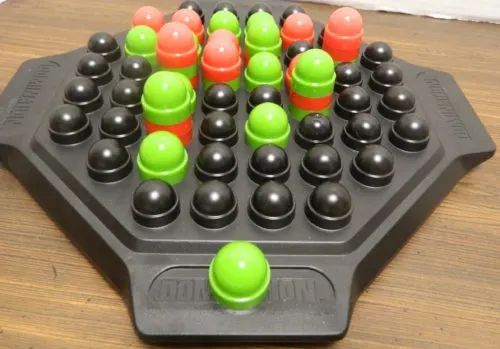
The green player has a piece in reserve. They can place this piece on any other piece or on an unoccupied space.
End of Game
The game ends when only one player can still move pieces. This means that one player has their colored pieces on top of all of the stacks and none of the other players still have reserve pieces. The last player who can make a move wins the game.
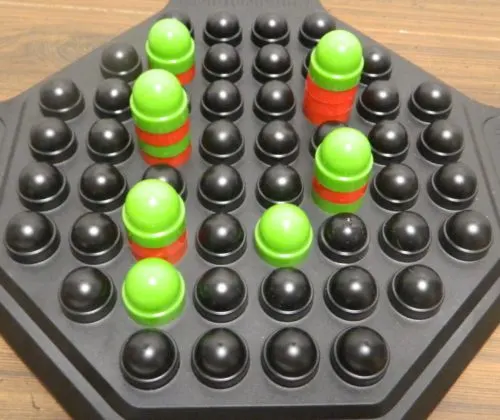
The green player is in charge of all of the stacks on the gameboard. Therefore the green player has won the game.
Players can also choose to use alternative win conditions for a shorter game. These alternative win conditions depend on the number of players.
- Two Players: The first player to capture six pieces of the other player wins the game.
- Three Players: The first player to capture ten pieces of any color (including their own) wins the game.
- Four Players: The first player to capture two pieces of each opponent’s color or ten total pieces (including their own) wins the game.
Partner Play
If you are playing with four players you can choose to either player individually or with a partner. If you choose to play with partners one team will be green and yellow and the other team will be red and blue. Partners have to sit across from one another so the teams alternate turns. Play will move clockwise with each player taking their own turn. The partner game plays the same as the normal game with the following additions:
- On your turn you may only move your own colored pieces.
- When your partner captures pieces of your color, they will give you the pieces to add to your reserves.
- If you cannot move on your turn you will pass your turn.
When playing with partners the game ends when both players on one team cannot make a move. The other team will win the game.
My Thoughts on Domination
At its core Domination is pretty much your typical abstract strategy game. The game has no theme and mostly revolves around figuring out how to move your pieces to capture the other player(s) pieces. This involves a lot of analyzing which pieces you should move to capture opponent’s pieces while keeping your own pieces safe. Anyone who has played an abstract strategy game before should have a good idea of what to expect from Domination.
As the gameplay in Domination mostly involves just moving pieces around the gameboard, the game is quite easy to play. Outside of figuring out which pieces you control and how many spaces the pieces can move, there isn’t much that you need to learn to be able to play the game. You could honestly teach Domination to new players within a couple minutes. With how simple the game is to play it should be accessible for most people. The game has a recommended age of 10+, but I could see younger children understanding the game enough to play it. They might not get all of the strategy, but they should understand the gameplay mechanics.
With Domination being an abstract strategy game it is not surprising that the game relies on quite a bit of strategy. In fact there is very little luck in the game. The only luck that is really in the game is the fact that in three and four player games a group of players could gang up on one of the other players. Otherwise there is no luck in the game. Your fate is determined by the actions you and the other players make in the game. In order to win the game you need to make smart strategic decisions while hoping the other player(s) make some bad moves.
As Domination relies on quite a bit of strategy, it means that it is the type of game that you will get better at the more you play it. The player(s) with more experience in the game will have a pretty significant advantage in the game. The more you play the game the better you will get at finding the best movement options. There is quite a bit to analyze before making any moves which can lead to some analysis paralysis. Choosing the right options in the game is critical though. While some games can be won with great moves, you are more likely to lose a game due to a bad decision. While a lot of the strategy comes from figuring out where you should move pieces, there are a couple other things that you should factor in when making a decision.
First stacking is quite important. Outside of the top piece deciding who gets to move it, the size of the stack determines how far the stack can move. This is really valuable in the game. Controlling tall stacks in the game gives you more options. The more pieces you have in the stack the further you can move it. You can also choose to move the stack fewer spaces. This flexibility gives you a lot of choices in where you want to move a stack. Due to this flexibility tall stacks are really valuable in the game. You want to protect them as the more tall stacks you control the better odds you have of winning the game. With how powerful they are though they become targets for other players. Capturing a tall piece from another player can drastically change the game.
For the most part I thought this mechanic was quite clever. The number of pieces in a stack controlling its movement is simple and yet makes a lot of sense. These stacks are really powerful but they also become big targets. Then there is the fact that you can split a stack at any point. If you have multiple pieces inside the stack you can break up a larger stack in order to have two pieces that you control. Outside of not being able to move the stacks as many spaces, it give you more control over the gameboard as you have more pieces that can capture enemy pieces.
The other area where some additional strategy is added to the game is through capturing and reserving pieces. When larger stacks capture one another the combined stack will have more than five pieces in it. When this happens the pieces on the bottom of the stack are removed from the gameboard. Pieces from players other than the capturing player are removed from the game. This helps quite a bit as it limits how many stacks the other player(s) can ultimately control in the game as these pieces can never re-enter the game. What might be even more important though is putting pieces into reserve. When one of your own pieces are on the bottom of the stack, you add the piece to your reserve. These pieces can be added back to the gameboard at a later time.
It might seem silly and against the premise creating a stack with multiple of your own pieces, but obtaining reserve pieces is key in the game. Reserve pieces are so valuable as they can be played on any future turn on any space on the gameboard. These pieces are so valuable that you want to keep them around until the end of the game or until a key moment in the game. The player with the most reserve pieces at the end of the game will have a huge advantage in the game. They are powerful because they can be placed on any space on the gameboard. This means they can be used to steal a large stack controlled by another player. If the other player has no reserve pieces left and only controls one stack, you can also use a reserve piece to end the game.
I have some mixed feelings about the reserve pieces. On the positive side they add strategy to the game. Choosing where to place a reserve piece can have a big impact on the game. Making the right choice for where to play a piece can significantly alter the game. Players could also make strategic moves in order to get reserve pieces. These mechanics add more strategy to the game which is almost always a positive for an abstract strategy game. Unfortunately the reserve pieces are too powerful. They are so powerful that if you have more of them at the end of the game you are going to have a very good chance of winning the game. Good luck winning the game if you have no reserve pieces at the end of the game.
Ultimately Domination deserves a lot of credit for being ahead of its time. For a game created back in 1963 it had a lot of mechanics that you didn’t really see back then. The stacking mechanics determining who gets to move a piece and how far they can move it was a pretty original idea for a 1960s game. Domination has some interesting mechanics and it can be fun in the right groups. People who like a good abstract strategy game should have some fun with Domination.
Unfortunately Domination has some issues which leads to the game being kind of overrated.
I would say that the biggest problem with Domination is the fact that the game has a significant stalemate problem. The stalemate problem affects two player games and when you get down to two players in a three or four player game. The problem occurs near the end of the game when both remaining players control about the same number of pieces and neither player can break the stalemate with reserve pieces. Once most of the pieces have been removed, there is a lot of empty spaces on the board. While controlling tall stacks allow you to traverse a lot of spaces, it is still quite easy for a player to run away from another player due to all of the empty spaces. Unless the player controls at least one more larger stack than the other player they will never be able to corner them and take their last piece. One player could keep running away or mirroring the other player’s moves so the game never ends. Players then have to either wait for one player to make a mistake so the other player can capitalize and capture their piece, or the players have to agree on a stalemate. Unless the players are really stubborn you might be better off just accepting the stalemate to save yourselves a lot of time. For this reason I would probably recommend using one of the alternate victory conditions as it will reduce the likelihood of a stalemate.
Other than the stalemate problem Domination also has a problem with the game becoming kind of dull after a while. Due to the gameplay being quite basic and the game having no theme, it can become a little boring. Basically every turn you are doing exactly the same things over and over again. Move a piece to a new space on the board hoping to capture other pieces. Rinse and repeat until the game is over. With no theme the game relies entirely on the gameplay. The gameplay is fun, but it gets repetitive after a while. It doesn’t help that the game takes quite a bit longer than it should as well. For a game that would be best at 15-20 minutes, games can regularly take over 30 minutes. This is due to the stalemate problem as well as the tendency of players to over analyze every decision made in the game.
Domination’s components are nothing special either. On the positive side I do give the game some credit as the pieces and the gameboard work well together. How the pieces and the gameboard are designed makes it really easy to stack pieces and move them to other spaces. The components are nothing special to look at though. They serve their purpose, but they are pretty basic plastic components. The opening setup for the game also takes quite a bit of time and you can easily make a mistake while placing the pieces. I would say the biggest problem with the components though is the fact that you could easily make your own copy of the game. All you need is a 6 x 6 grid and some checkers or other pieces that you can stack on top of one another. You will need to modify the grid a little but it would be really easy to make your own copy of the game. The only reason why I wouldn’t recommend making your own copy is that while not the most common board game, you can find copies of the game for pretty cheap at thrift stores or rummage sales.
While I mentioned earlier that Domination was before its time, at this point it may be a little outdated. That is not all that surprising for a board game that is over 50 years old. The problem is that in the last 50 years other board games have taken what was introduced in Domination and improved upon it. While there haven’t been a ton of games that have utilized the mechanic, there have been enough that almost make Domination obsolete at this point. For example we have looked at Crab Stack which while not exactly the same shares a very similar premise. Then there is the highly rated DVONN which basically takes all of the mechanics from Domination, improving on them and adding some mechanics that should help with the stalemate issues. While you can still have fun with Domination, there are better games that use a very similar concept which makes you wonder if it even pays to go back and play Domination.
Should You Buy Domination?
Domination is the very definition of a very solid but unspectacular abstract strategy game. On the positive side the game is really easy to play as you can explain it to new players within minutes. The game also relies on very little luck. The player with the best strategy that makes the least mistakes is very likely to win the game. Domination even deserves a lot of credit with coming up mechanics that were ahead its time. The stacking mechanic determining control and how far a piece can move was unique for the 1960s. You can have fun with the game as there are quite a few strategic decisions which makes Domination a game that you have to play quite a bit to truly master. The problem is that Domination has some issues. The game has a significant stalemate problem. The game can also get a little boring after a while. The board game industry has also moved on from Domination creating other board games with similar mechanics that have improved on Domination’s formula.
If you don’t really care for abstract strategy games, already own another similar game, or don’t really care for the game’s concept; I don’t see Domination being for you. Fans of easier to play abstract strategy games though should get quite a bit of enjoyment out of Domination, and should consider picking it up if they can get a good deal on it.
If you would like to pick up Domination you can find it online: Amazon, eBay

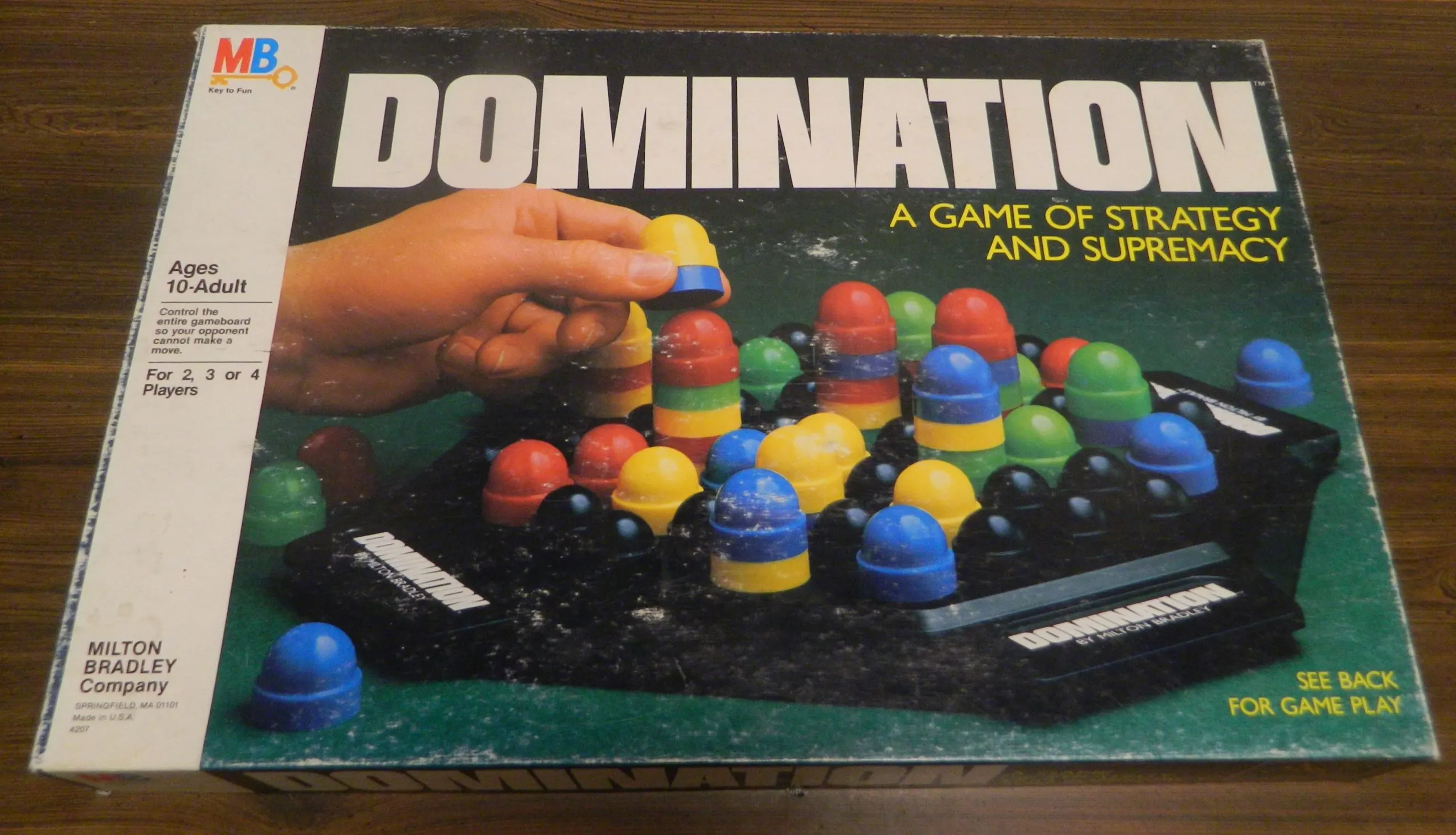
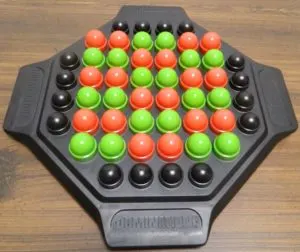
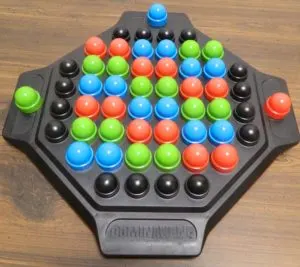
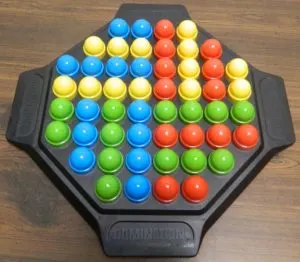
James Wood
Monday 30th of March 2020
What an incredible game to spend a weekend playing! This is a fantastic game for strategy lovers. I learned about this Domination game, and it is now by far my favorite strategy board game. If you like crunchy strategy games with everyone involved with each other's turn you will love this game. My favorite board game ever. All in all, if you have a few friends, you can get together with for 4-6 hours pretty consistently, I absolutely recommend this game.
Joe @ Amazing Game Room
Tuesday 3rd of September 2019
So weird that you posted this review of this old game today. I'm staying in a hotel where they have all sorts of old board games for guests to play and I happen to see it on the shelf. Didn't play it, but it's something I haven't seen in ages! I've played it before and agree with you that the stalemate thing can be kind of a drag.